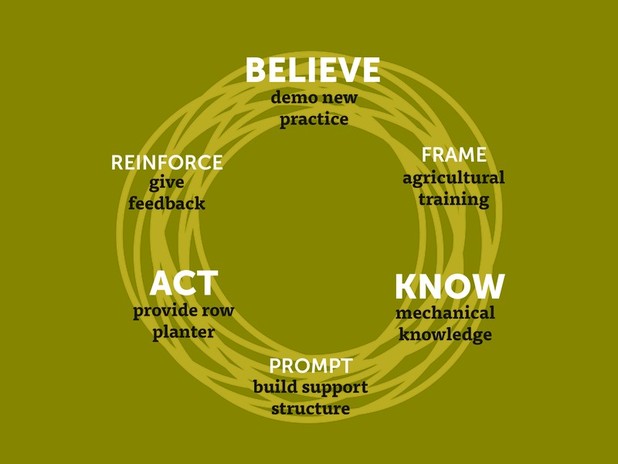December 16, 2013
Martin Schnitzer and the Teff Mudders team working in Ethiopia to design a teff row planter explore the adherence loop, a method used to facilitate behavior change.
Today we’ll post a section of the kick-off presentation we gave to the Ethiopian Agricultural Transformation Agency (ATA). We had a great meeting with a true multidisciplinary team on both sides, which allowed us to hear everybody's point of view. The ATA brought together us designers and engineers as well as agronomists. It's a fantastic feeling to move forward knowing that our goals are aligned.
The section we'd like to share is a piece of human-centered design that’s not in the current HCD Toolkit. You blog-followers and teff planter groupies are in for a treat!
The adherence loop was developed many years ago for health care projects. (I’m dating myself for even knowing about it but I blame Dennis Boyle, our advisor and founding member of IDEO, for suggesting it.)
The challenge with behavior change is to make it last. Designing for adherence, however, can help make behavior stick! It can be defined as taking prescribed actions to gain the maximum benefit. By seeing the behavior change we want—getting Ethiopian farmers to plant teff in a new way—as a design opportunity, we created this tool to guide both research and design.
Think of yourself when you try to change a behavior. You might have tried to adjust your diet or decided to exercise more. But understanding the benefit of your intended change is much easier than following through with it over time.
In our case, we're asking farmers to change how they plant teff, something they've been doing in the same way for millennia. Can you imagine how scary this change must be for these farmers? They've got no safety net, no unemployment benefits, just a farmer, a family, and a plot land.
That’s why just providing them with a new row planter isn’t enough. It is just one step (ACT) in the adherence loop. We need to consider their environments, support them along the way, and give them feedback.
BELIEVE - Seeing is believing. Demonstrate how the row planter helps to increase yield. Make farmers feel they can be successful.
FRAME - Give access to agricultural training. Build a relationship that goes beyond financial means.
KNOW - Teach farmers how to use the tool and how to service it.
PROMPT - Knowing what to do is often not enough. People need cognitive, social, and financial support to prompt action.
ACT - Provide a functional row planter.
REINFORCE - People need feedback to understand how they are doing. Provide mechanical support to keep the planter operational.
Is the adherence loop relevant to your work/project?
Try to adopt it!



